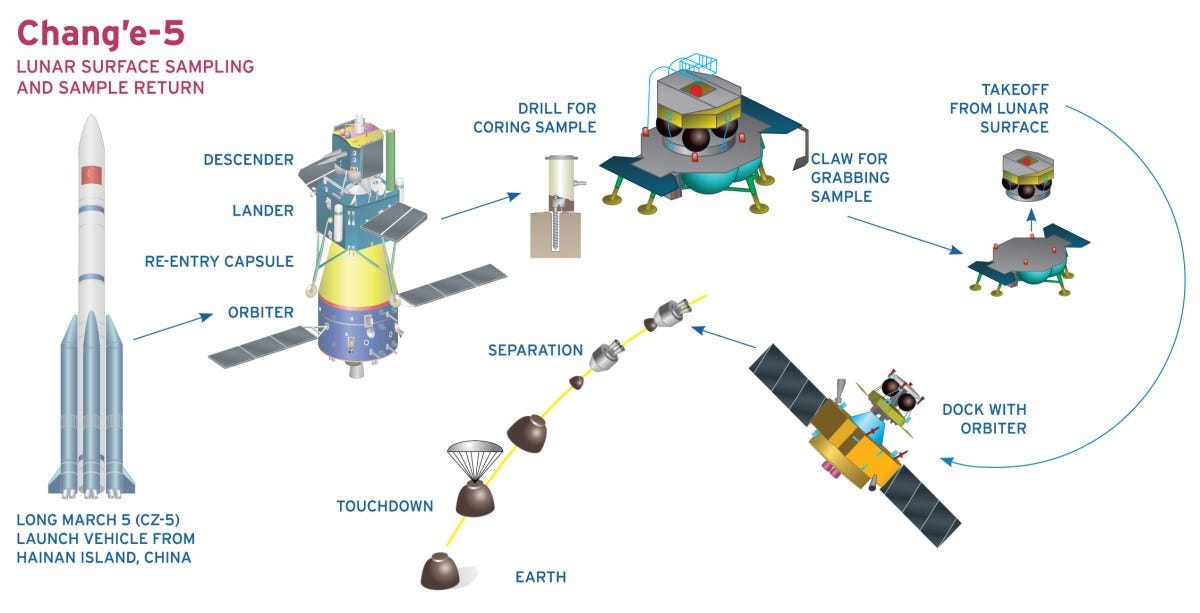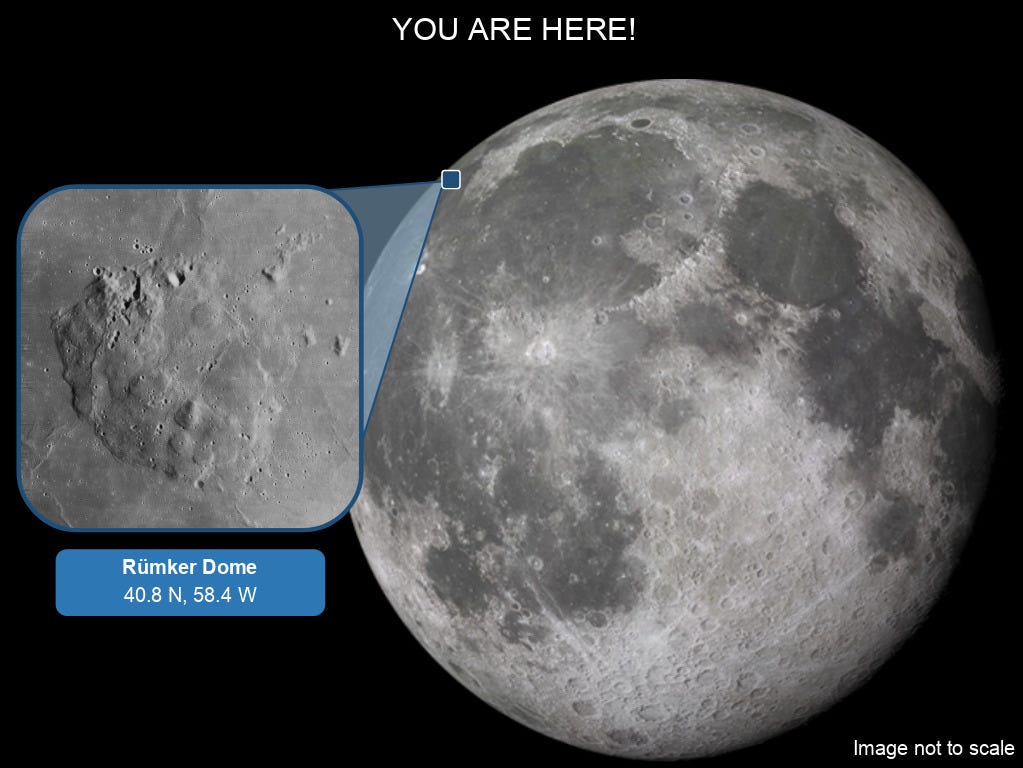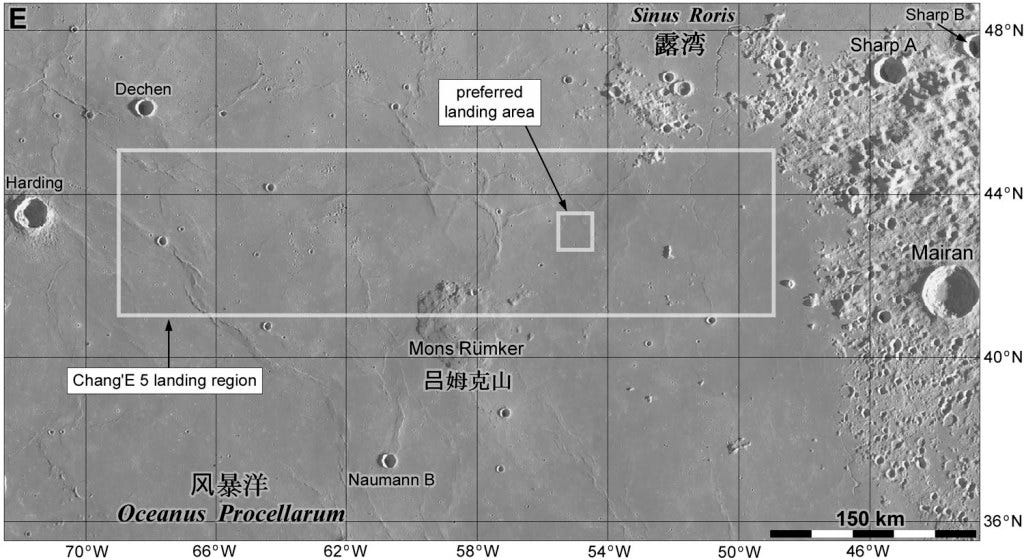Chang’e 5 landing site: Near the volcanic complex of Rümker
China has returned Moon samples from a sweet scientific spot for their first sample return mission.
On December 16, China successfully completed the Chang’e 5 mission to bring samples from the Moon, their first such endeavor. The last time lunar samples were fetched was when the Soviet Union sent three robotic missions between 1970 to 1976, returning about 300 grams of material to Earth.

Scientists use Moon samples to determine precise ages of places and then use that to calibrate the ages of features on worlds like Mars, Mercury and moons across the Solar System. Chang’e 5 samples are an appreciable addition to the three samples from Luna and six from Apollo.
The mission’s landing site was in a volcanic complex on the Moon called Rümker, which is thought to have formed less than two billion years ago. That places it in a scientific sweet spot––samples from past missions are either younger than 850 million years or older than 3 billion years.
We know from data provided by past surface missions and orbiters that the Moon has experienced several distinct periods of volcanism in the last four billion years. Lava oozing out of openings on the surface during such times have formed broad volcanic domes. Mons Rümker, part of the Rümker region, is one such dome made up of multiple stacks of volcanic mounds. It’s a type of a feature never before physically studied on the Moon.

Rümker dome spans 70 kilometers wide, making it the largest one on the Moon. Its highest point is about 1.3 kilometers tall, much shorter than typical lunar mountains that rival ones on Earth. Being more broad than tall, Rümker dome has fairly gentle slopes overall. A thorough analysis of the dome by Jiannan Zhao, Long Xiao, et al. shows that 75% of the dome has slopes less than three degrees, though some mounds are quite steep. However, Chang’e 5 didn’t land on Rümker dome, and instead targeted a plain northeast of the dome.

This nearby area is part of the volcanic complex and has the same material as the dome itself, meaning it formed from the same event. But it makes more engineering sense as it’s less riskier to land on than the dome. The scientific rationale is that at about 1.2 billion years old (per orbital measurements), the landing area is deemed to be among the youngest features of the volcanic complex. Studying the Chang’e 5 samples will provide insights on the Moon’s interior too, specifically about the mantle that lies below the crust.
Since the Moon is airless and has no magnetic field, its surface is constantly bombarded with radiation and micrometeorites that alter the material’s intrinsic properties, including samples Chang’e 5 scooped from the surface. This is why the Chang’e 5 spacecraft was equipped with a robotic arm and a drill to dig samples from up to two meters below the surface, where the samples shouldn’t have such severe dilution, allowing for a pristine peek into its formation era.
The returned capsule was weighed to have brought back ~1.7 kilograms of samples, instead of the planned 2 kilograms. That’s because the drill sampling was restricted to a depth of 1 meter instead of the planned 2 meters, as it turned out that the subsurface was more rocky than expected. If these samples are diluted by radiation and micrometeorites too, then it will still provide a record of solar radiation and galactic cosmic rays over millions of years.
If analyses of samples from the Rümker region reveals that it indeed formed recently, geologically speaking, it would mean the Moon was thermally active for over three billion years. Determining what Rümker’s rocks are made of will reveal details of this thermal history. Emily Lakdawalla notes in her Chang’e 5 post that the region is rich in––compared to the rest of the Moon––radiogenic heat-producing elements such as thorium, uranium, and potassium.
Chang’e 5 hopefully represents just the first in what should be a renewed streak of sample return missions to the Moon. Now that Chang’e 5 is successful, China will be repurposing its backup mission, Chang’e 6, to bring samples from the Moon’s south pole. Meanwhile, NASA is aiming to bring polar samples too in this decade via its Artemis program. After expressing interest in buying Moon samples from commercial companies, to incentivize the companies to build such technologies and help scientists get samples from multiple places on the Moon, NASA selected four companies to collect lunar material for them (note: collect, not return to Earth) and transfer its ownership to the agency.
While the Apollo and Luna samples revolutionized our understanding of the Moon’s origin, they were from largely similar geological areas and thus not representative of the entire Moon. To continue piecing together the complex origin and history of the Earth-Moon system, we need samples from new locations. Chang’e 5 is the first such start.
This post was made possible thanks to Sourabh Maltare supporting me on Patreon.
Like what you read? Support me to keep me going.
